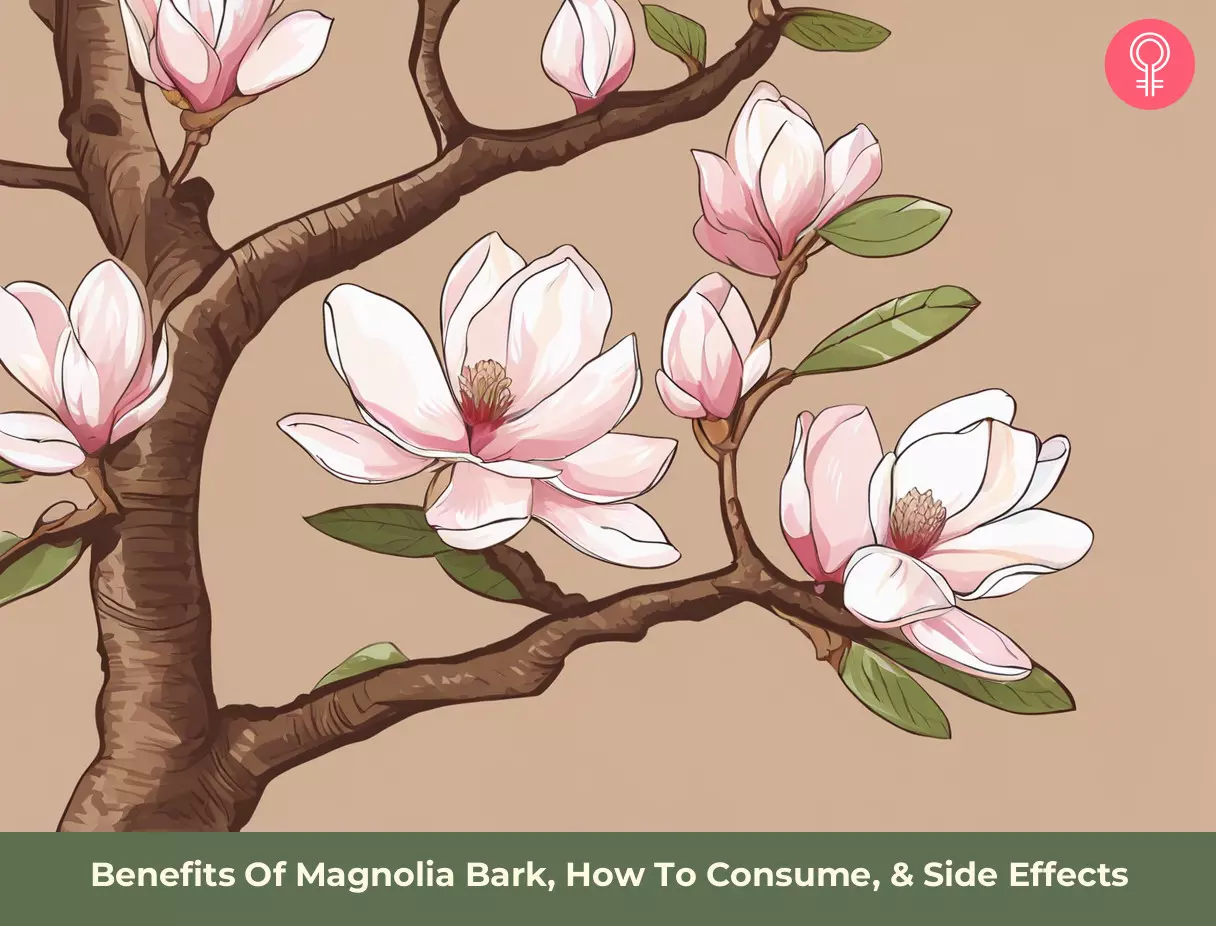10 Benefits Of Magnolia Bark, How To Consume, & Side Effects
Adding this extract to your diet can protect you from severe health issues in the long run!

Image: Shutterstock
Traditional Chinese medicine has long recognized the benefits of magnolia bark. Magnolia bark has been used for centuries to manage depression, low blood pressure, promote brain health, and even reduce menopause symptoms. Researchers have linked these health benefits to its high bioactive compoundsi Chemical compounds found in fruits, vegetables, and whole grains. They help improve heart health and have anti-cancer properties. content. This article discusses the benefits of magnolia bark, recommended dosage, and possible side effects. Scroll down.
 Know Your Ingredient: Magnolia Bark
Know Your Ingredient: Magnolia BarkWhat Is It?
A traditional Chinese herb used for centuries to treat a variety of conditions for its potential medicinal properties.
What Are Its Benefits?
It aids with the management of insomnia, depression, low blood pressure, and menopause symptoms.It helps regulate the glycemic index, reduces inflammation, and supports healthy digestion and brain function.
Who Can Use It?
Anyone except pregnant women, as it can cause contractions and lead to miscarriage.
How Often?
250 to 500 mg per day
Caution
May interfere with anesthesia, anxiety, depression medications and blood thinners.
In This Article
What Are The Benefits Of Magnolia Bark?
1. Improves Dental Health

Studies show that the antimicrobial properties that the bark contains can fight dental plaque. In the research, chewing gums containing magnolia bark, when assessed, were found to reduce dental plaque (1).
And these very antimicrobial properties also help one fight bad breath. Magnolia can also fight cavities, as per studies (2).
Another Italian study particularly speaks of how magnolia extract can reduce the volatile sulfur-containing compounds in the oral cavity and improve overall teeth health (3).
2. Magnolia Bark Can Lower Blood Pressure

Honokiol, one compound in the magnolia bark, was found to relax the aortas and lower blood pressure (4). Though we need more research on this, this sure is a step in the right direction.
 Did You Know?
Did You Know?3. Fights Inflammation
Magnolia bark extract, when administered to cells, had reduced the amount of pro-inflammatory cytokines – compounds that lead to inflammation (5).
The bark can also reduce the pain that is caused by inflammation. Two compounds in magnolia bark, honokiol and magnolol, were found to reduce the pain that was a result of bodily inflammation (6).
4. Relieves Menopause Symptoms
Comparative studies between magnolia bark and soy isoflavones in treating menopausal symptoms offered interesting results – the bark was able to lower stress and treat anxiety, which are some of the symptoms in menopausal women (7).
In fact, adding the bark extract to isoflavones further improved the symptoms – the combination could effectively combat insomnia, irritability, depressed mood, and even loss of libido (common symptoms during menopause) (8).
5. Can Aid Diabetes Treatment

Some of the major bioactive compoundsi Chemical compounds found in fruits, vegetables, and whole grains. They help improve heart health and have anti-cancer properties. in magnolia bark were found to contribute to glycemic control – and this is a boon for diabetics (9). These compounds, upon further research, were also found to possess hypoglycemic bioactivity – meaning they have the ability to lower blood sugar levels.
Magnolia bark is also effective against oxidative damage of the liver, which can happen in severe cases of diabetes (10).
6. Helps Fight Cancer
The honokiol in magnolia bark can fight cancer in a number of ways. In fact, in one animal study, the combination of radiation and honokiol caused a greater reduction in tumor volumes as opposed to using radiation alone (11).
Honokiol was also found to block a specific cancer pathway that was previously thought to be resistant to drugs (12).
In yet another study, honokiol was found to prevent breast cancer – which could otherwise be caused by leptin, one hormone closely associated with obesity (13).
7. Fights Depression And Boosts Cognitive Health
A mixture of honokiol and magnolol (the two compounds in magnolia bark) was found to offer antidepressant benefits, according to studies (14). These two compounds also increase the serotonin levels in the prefrontal cortex, the low levels of which are linked to depression (15).
Honokiol and magnolol are also linked to elevated levels of noradrenaline, which is associated with improved alertness and concentration, along with enhanced emotions.
 Quick Tip
Quick TipFurther research also shows us how magnolia bark works as a traditional medicine and can reduce memory loss and help in the treatment of Alzheimer’s (16).
8. Helps Treat Insomnia

By lowering cortisol levelsi It indicates the amount of cortisol in the blood. Cortisol is known as the body’s stress hormone. , magnolia bark aids in the relaxation of the body and the mind. Taking this herb right before you go to bed can help you sleep better as it promotes rapid drowsiness.
Research also shows us that the honokiol in magnolia bark promotes non-rapid eye movement, thereby treating insomnia and helping the body and mind relax and drift to sleep (17).
9. Might Promote Weight Loss

Some research shows how magnolia bark could reduce body fat mass in mice. And the honokiol in the bark had decreased insulin resistance, thereby preventing fat storage (18).
10. May Improve The Skin Health
Magnolia bark contains the natural compounds magnolol and honokiol that provide several benefits to your skin. They help reduce inflammation and prevent skin diseases, including skin cancer. Studies show that honokiol prevents skin cancer caused by UV radiation by activating proteins that cause cell death. Magnolol has also been proven to inhibit the spread of melanoma cells (19).
The compounds also have anti-inflammatory and antimicrobial benefits. These properties make the magnolia bark an effective solution for skin disorders, including psoriasis, vitiligo, lupus, and skin fibrosis (20). Magnolol may also reduce the secretion of inflammatory substances induced by Propionibacterium acnes. Thus, you may use it to manage acne (19).
 Trivia
TriviaWell, these are the benefits. We know you already are thinking of including this bark in your diet. But how?
Key Takeaways
- Certain compounds in Magnolia bark help reduce inflammation as well as soothe any pain from it.
- It also reduces tumors and helps fight cancer in many ways.
- It has also shown effectiveness in weight management and fat loss.
- Magnolia bark extracts can be blended and taken with water, smoothies, or in any other way preferable.
How To Consume Magnolia Bark Extract
The bark (or the extract) is quite soluble in water. Hence, you can mix it in a glass of plain water or juice.
A YouTuber eagerly shared the intricate steps of crafting magnolia bark tincture. Demonstrating the meticulous peeling of magnolia sticks involved in the process, he highlights, “You take the whole of the top layer of bark off (i).” He also stresses upon the choice of alcohol he used for the tincture: “You want to use grain alcohol or alcohol that’s safe for drinking” to ensure a potent and safe final product.
You can also add the extract to your breakfast smoothie. Other ingredients in the smoothie can help mask the bark’s taste in case it doesn’t appeal to you. You can also take them in the form of natural health supplements.
The dosage of the extract should be between 250 to 500 mg per day. If you are a beginner, start with a lower dosage of 250 mg and gradually increase it, monitoring your body’s response to the supplement. This approach allows you to assess your tolerance and minimize the risk of potential side effects.
Always consult with a healthcare professional before starting any new supplement regimen, especially if you have existing health conditions or take prescription medications.
Great. But does this mean anybody can take the extract? Maybe not. There are certain things to be kept in mind.
What Are The Side Effects Of Magnolia Bark?
- Issues During Pregnancy And Breastfeeding
Some research suggests that taking magnolia during pregnancy can cause uterus contractions and lead to miscarriage. Not enough is known about its effects on breastfeeding. Hence, stay safe and avoid use in both the cases.
- Might Make Anesthesia Ineffective
Magnolia can slow down the nervous system due to its relaxing properties. This might be a problem during surgery as the anesthesiai A state induced by a drug given to patients during surgery or diagnostic procedures causing a temporary loss of sensation application may not be as effective. Stop use at least two weeks before a scheduled surgery.
Infographic: Fascinating Facts About Magnolia Bark
Magnolia bark has been used in traditional Chinese medicine for its medicinal values. The bioactive and polyphenolic compoundsi Natural compounds found in fruits and vegetables. They act as antioxidants and help the body fight diseases. in it offer many health benefits. From improving lung health to eliminating phlegm, this herbal remedy improves several health conditions. Click on the infographic below to learn some fascinating facts about magnolia bark. Illustration: StyleCraze Design Team
Magnolia bark’s benefits can be attributed to its bioactive compoundsi Chemical compounds found in fruits, vegetables, and whole grains. They help improve heart health and have anti-cancer properties. . It promotes dental health, lowers blood pressure, combats inflammation, and relieves menopause symptoms. It also aids in the treatment of diabetes, helps fight cancer, boosts cognitive health, and helps fight depression. In addition, it helps treat insomnia, promotes weight loss, and helps to enhance overall wellness. It can be mixed with water or juice for consumption. However, it may cause issues during pregnancy and breastfeeding and may make the action of anesthesiai A state induced by a drug given to patients during surgery or diagnostic procedures causing a temporary loss of sensation. less effective. Hence, caution is advised. Having it in moderate amounts helps reap its benefits.
Frequently Asked Questions
Does magnolia bark increase dopamine?
Yes. There is an association between depression and depletion of monoamine (like dopamine) (21). Magnolia bark exhibits anti-depressant properties that may help improve dopamine levels.
Is magnolia bark a blood thinner?
Yes. Anecdotal evidence suggests that the presence of bioactive compoundsi Chemical compounds found in fruits, vegetables, and whole grains. They help improve heart health and have anti-cancer properties. in the stem bark of magnolia exhibits anticoagulanti Substances that stop or prevent blood coagulation (clotting of blood). They help reduce the risk of stroke. properties. However, limited data is available in this regard.
Is magnolia bark a benzodiazepine?
Magnolia bark contains a bioactive compound called magnolol, which induces sleep via benzodiazepine receptor (22).
Is magnolia bark fat-soluble?
Yes. Magnolia bark is fat-soluble.
Does magnolia bark aid digestion?
Yes, magnolia bark has been traditionally used to treat gastrointestinal disorders and may help to improve digestion by increasing the level of gut bacteria (8).
Illustration: Benefits Of Magnolia Bark How To Consume & Side Effects

Image: Stable Diffusion/StyleCraze Design Team
Discover the amazing health benefits of magnolia bark! From reducing inflammation to improving sleep, this natural remedy has it all. Click on the video below to learn more about it.
Personal Experience: Source
StyleCraze's articles are interwoven with authentic personal narratives that provide depth and resonance to our content. Below are the sources of the personal accounts referenced in this article.
i. How to Make Magnolia Bark Tincture!https://www.youtube.com/watch?v=_KBHtas0rrw
References
Articles on StyleCraze are backed by verified information from peer-reviewed and academic research papers, reputed organizations, research institutions, and medical associations to ensure accuracy and relevance. Read our editorial policy to learn more.
- “Dental plaque regrowth studies to…”. ScienceDirect.
- “The antibacterial effect of Magnolia mouthwash…“. US National Library Of Medicine.
- “The effect of zinc acetate and…”. US National Library of Medicine.
- “Effects of chronic treatment with…”. US National Library of Medicine.
- “Identification of magnolia extract…”. US National Library of Medicine.
- “Effects of honokiol and magnolol…”. US National Library of Medicine.
- “Magnolia bark for anxiety...”. Dr. Weil.
- “Biological activity and toxicity of the…”. US National Library of Medicine.
- “Extracts of magnolia species…”. US National Library of Medicine.
- “The antidiabetic and hepatoprotective…”. US National Library of Medicine.
- “Honokiol: a novel natural agent...”. US National Library of Medicine.
- “Honokiol Suppresses Survival Signals…“. ResearchGate.
- “Can magnolia help break the link…”. Johns Hopkins University.
- “Anti-depressant like effects of the...”. US National Library of Medicine.
- “Anti-depressant like synergism of…”. US National Library of Medicine.
- “A comparison between extract products of...”. US National Library of Medicine.
- “Honokiol promotes non-rapid eye movement…”. US National Library of Medicine.
- “The magnolia bioactive constituent…”. US National Library of Medicine.
- “Honokiol and Magnolol as Multifunctional Antioxidative Molecules for Dermatologic Disorders”. US National Library of Medicine.
- “The application prospects of honokiol in dermatology”. US National Library of Medicine.
- “Biological activity and toxicity of the Chinese herb Magnolia officinalis Rehder & E. Wilson (Houpo) and its constituents”. Journal of Zhejiang University Science.
- “Magnolol, a major bioactive constituent of the bark of Magnolia officinalis, induces sleep via the benzodiazepine site of GABA(A) receptor in mice”. US National Library of Medicine.
Read full bio of Mollie Meldahl
Read full bio of Ravi Teja Tadimalla
Read full bio of Arshiya Syeda
Read full bio of Aparna Mallampalli


























Community Experiences
Join the conversation and become a part of our empowering community! Share your stories, experiences, and insights to connect with other beauty, lifestyle, and health enthusiasts.